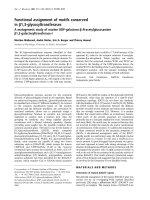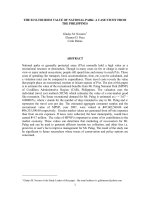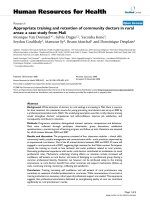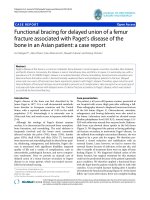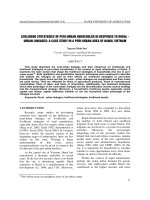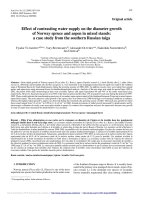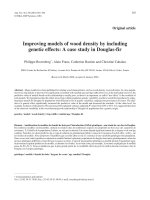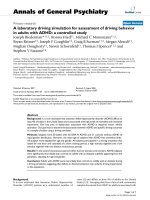Problems of decision making in rural development NGOs a case study from india
Bạn đang xem bản rút gọn của tài liệu. Xem và tải ngay bản đầy đủ của tài liệu tại đây (1.85 MB, 314 trang )
i
PROBLEMS OF DECISION-MAKING
IN
RURAL DEVELOPMENT NGOs: A CASE STUDY FROM
INDIA
SARITA SESHAGIRI
NATIONAL UNIVERSITY OF
SINGAPORE
2003
ii
PROBLEMS OF DECISION-MAKING
IN
RURAL DEVELOPMENT NGOs: A CASE STUDY FROM INDIA
SARITA SESHAGIRI
(B.A. (Hons), LADY SHRIRAM COLLEGE, DELHI UNIVERSITY,
M.A. JAWAHARLAL NEHRU UNIVERSITY
M.Phil. JAWAHARLAL NEHRU UNIVERSITY)
A THESIS SUBMITTED
FOR THE DEGREE OF DOCTOR OF PHILOSOPHY
DEPARTMENT OF POLITICAL SCIENCE
NATIONAL UNIVERSITY OF
SINGAPORE
2003
i
ACKNOWLEDGEMENTS
There are many people, who made it possible for me to reach this stage of my
academic pursuit over the past four years. First and foremost, I thank my supervisor,
Associate Professor Dr. Shamsul Haque, for his constant guidance and abundant
patience. His invaluable criticism pushed me to work harder, while his flexibility and
understanding made this seemingly arduous enterprise a very pleasant journey.
I am grateful to Dr. Yusaku Horiuchi, who helped me improve my research
methodology. In fact, his course on research methods provided me with new insights
on how a meaningful study should be conducted. I would also like to thank Dr. Kripa
Sridharan for her invaluable advice right at the beginning of my programme. She had
impressed upon me the importance of conducting a realistic and ‘doable’ research,
rather than undertaking an ambitious and potentially impossible enterprise.
I also thank the Chairman and staff members of AWARE, Professor Madduri, Dr.
Shankuntala Narasimhan, Ms. Sameeksha Thakur and Mr. MK Bhat for their valuable
time. Without their interviews, this study would never have been possible.
I thank Stephanie, Jamuna, Mumtaj, Sani and Harlizah for their timely assistance
at the Department’s general office. I could always count on them to lead me through
complicated administrative hurdles.
Last but not least, thank you Vinay, Appa, Amma, Sahana and Vikas for standing
by me and being there whenever I needed you. Your love and confidence in me was, is
and will always be the source of my strength and purpose in life.
ii
TABLE OF CONTENTS
SUMMARY vii
LIST OF ABBREVIATIONS / ACRONYMS ix
Chapter One
A Case Study from India 1
INTRODUCTION 1
STATEMENT
OF
PROBLEMS 4
SIGNIFICANCE
OF
THE
STUDY 9
OBJECTIVES
OF
THE
STUDY 11
HYPOTHESES
OF
STUDY 12
ANALYTICAL
FRAMEWORK 14
Research Components 14
Decision Models 15
RESEARCH
METHODOLOGY 20
Operationalisation of Variables 21
Techniques of Data Collection 23
Categories of respondents 24
STRUCTURE
OF
THE
STUDY 26
LIMITATIONS
OF
THE
STUDY 28
Chapter Two
Literature Review 30
MEANING
AND
LOCATION
OF
NGO
S
30
Definition of NGOs 30
Location of NGOs 31
THE
RISE
OF
NGO
S
AND
ITS
CAUSES 33
EVOLUTION
AND
GROWTH
OF
NGO
S
IN
INDIA 39
DECISION-MAKING
AND
ITS
SIGNIFICANCE
IN
NGO
S
42
PAUCITY
OF
CURRENT
LITERATURE
AND
THE
STUDY 50
Decision-making and attributes of NGOs 51
Influences on decision-making within Indian NGOs 53
Research on AWARE’s decision-making 57
Evaluation of NGO decision-making 58
Theoretical tools to study NGO decision-making 61
Chapter Three
A Case from India – AWARE 63
ANDHRA’S
POLITICAL
TERRAIN 63
JUSTIFICATION
FOR
CHOOSING
AWARE 66
Goals and functions 66
Relations with stakeholders 68
iii
Size and influence 68
Success and achievements 69
AWARE’
S
ORIGIN 70
AWARE’S
OBJECTIVES
AND
STRATEGIES 71
Education 72
Poverty eradication 72
Health 73
Women’s empowerment 74
AWARE’
S
STRUCTURE
AND
STAFFING 76
FUNDING
SOURCES 83
AWARE’
S
CHALLENGES 84
AWARE’
S
ACHIEVEMENTS 86
CONCLUSION 91
Chapter Four
Health Programmes – AWARE’s Experience 93
L
ANDMARK PROJECTS IN
H
EALTH FROM THE
1970
S TO
2000 94
Health Centre at Chinnapuram (1979) 94
Factors influencing project decisions 95
Major impacts 97
Mobile Health Clinic (1981) 98
Factors influencing project decisions 100
Major impacts 101
Midwives and Voluntary Health Workers (VHWs) (1982) 102
Factors influencing project decisions 103
Major impacts 105
Food and Nutrition programme (1983) 106
Factors influencing project decisions 107
Major impacts 108
The Boat Hospital (1984) 110
Factors influencing project decisions 111
Major impacts 113
Community health centre at Padkal (1987) 114
Factors influencing project decisions 116
Major impacts 117
Latur’s earthquake relief (1993) 118
Factors influencing project decisions 119
Major impacts 121
“Shantivanam” - the Multi-Speciality Hospital (1999) 122
Factors influencing project decisions 123
Major impacts 125
Health Loans (2002) 127
Factors influencing project decisions 128
Major impacts 129
THE
INCREMENTAL
MODEL
AND
DECISIONS
IN
HEALTH
PROJECTS 130
Chapter Five
Education Programme - AWARE’S Experience 135
L
ANDMARK PROJECTS IN
E
DUCATION FROM THE
1970
S TO
2000 136
Education in Property Rights (1975) 136
Factors influencing project decisions 137
Major impacts 138
iv
Training in Legal Rights (1982) 139
Factors influencing project decisions 140
Major impacts 143
Training given to Chaitanya Nidhi’s resource people (1984) 144
Factors influencing project decisions 146
Major impacts 147
Yenadi Tribal Development Project (1988) 148
Factors influencing project decisions 150
Major impacts 151
Good Voters’ Programme (1994) 152
Factors influencing project decisions 154
Major impacts 155
Bliss Foundation (1997) 156
Factors influencing project decisions 157
Major impacts 159
Project on training Task Force for Rural Development (TFRD) (1998) 160
Factors influencing project decisions 161
Major impacts 163
Veterinary training programme (1999) 164
Factors influencing project decisions 166
Major impacts 167
“Deemed University” (2000) 169
Factors influencing project decisions 170
Major impacts 172
THE
INCREMENTAL
MODEL
AND
DECISIONS
IN
EDUCATION
PROJECTS 173
Chapter Six
Poverty Eradication - Women’s Empowerment Programmes -
AWARE’s Experience 179
L
ANDMARK PROJECTS IN POVERTY ERADICATION AND WOMEN
’
S EMPOWERMENT SINCE THE
1970
S
. 180
Chaitanya Shakti (1981) 180
Factors influencing project decisions 181
Major impacts 182
Poultry farming (1983) 184
Factors influencing project decisions 184
Major impacts 185
Chaitanya Nidhi (1985) 186
Factors influencing project decisions 188
Major impacts 189
Women as property owners (1986) 190
Factors influencing project decisions 191
Major impacts 192
Skill training for women (1987) 194
Factors influencing project decisions 195
Major impacts 196
Dandakaranya Tribal Development Project (DTDP) (1991) 197
Factors influencing project decisions 198
Major impacts 200
Formation of AWARE India Foundation (AIF) (1994) 201
Factors influencing project decisions: 202
Major impacts 203
Gram Lakshmi Scheme (1996) 205
Factors influencing project decisions 206
Major impacts 207
MACS (Mutually Aided Co-operative Society) (1998) 208
Factors influencing project decisions 209
Major impacts 211
v
Chetana Bazaar (1998) 212
Factors influencing project decisions 213
Major Impacts 214
THE
INCREMENTAL
MODEL
AND
DECISIONS
IN
WOMEN’S
EMPOWERMENT/
POVERTY
ERADICATION
PROJECTS 216
Chapter Seven
Decision-Making In AWARE - How Effective Has It Been? 221
THE
HEALTH
DOMAIN 221
Changes in project objectives 221
Factors influencing changes in objectives 223
The Chairman’s preference 223
Beneficiaries’ influence 224
Board members’ preference 225
Donors and government’s preference 225
AWARE’s incipience and lack of expertise 226
Preference of AWARE’s middle staff members 226
Mode of decision-making 226
Theoretical analysis of changes in objectives 228
EDUCATION
DOMAIN 232
Changes in project objectives 232
Factors influencing changes in objectives 234
Rural functionaries’ role 234
The Chairman’s preference 234
Board members’ preference 235
Role of AWARE’s upper and middle level staff 236
Beneficiaries and elite’s influence 236
Mode of decision-making 237
Theoretical analysis of changes in objectives 238
POVERTY
ERADICATION
/
WOMEN’S
EMPOWERMENT 243
Changes in project objectives 243
Factors influencing changes in objectives 245
Role of CDOs 245
The Chairman’s preference 246
Role of AWARE’s middle and upper level staff 246
Board’s preference 246
Beneficiaries’ preference 247
Role of donors and government: 247
Mode of decision-making 248
Theoretical analysis of changes in objectives 249
SUMMARY 254
Chapter Eight
Recommendations and Conclusions 257
OVERALL
FINDINGS 257
SPECIFIC
FINDINGS
AND
INFERENCES 262
Change in objectives 262
Factors affecting change in objectives 263
Change in mode of decision-making 267
RECOMMENDATIONS 270
Recommendations for AWARE 270
Relevance of AWARE’s experience to other NGOs 273
vi
Relevance of decision models 275
Further studies 278
BIBLIOGRAPHY 281
PRIMARY
SOURCES 281
SECONDARY
SOURCES 282
Books 282
Articles 286
Newspapers 288
APPENDIX i
INTERVIEW
SCHEDULE
I
For Academics / Consultants, i.e. those who have researched on AWARE i
Following questions for response from beneficiaries iii
For response from AWARE’s members. xi
vii
SUMMARY
Non-government organisations (NGOs) are becoming more and more significant
in India, due to the country’s overburdened state, poverty, democracy and plural
society. The state cannot reach the poor, whilst the market with its profit motive does
not have the incentive to empower them. Therefore, autonomous, civil society
institutions like NGOs are seen as fostering people’s participation through a bottom-up
approach.
This makes the study of NGOs significant. The purpose here is to explore how
NGOs in India decide to fulfil goals. For this, the study examines how external factors
(influences of the state, donors and beneficiaries) and internal factors (NGOs’
leadership style, personnel, and organisational structure) influence their decisions. It
also examines how NGOs pursue their objectives when faced with these influences.
Government agencies, donors and beneficiaries can be hostile. In fact, the government
exerts pressure through its acts and statutes. Donors also constrain by placing a
premium on their monetary assistance to NGOs. They expect quick results and their aid
structures are insensitive to beneficiaries’ socio-economic problems. Beneficiaries too
constrain NGOs through hostility, and lack of motivation in project participation.
Consequently while making decisions on rural development, NGOs have to adopt
the best strategy to confront these pressures. Effective decisions are needed for these
organisations to prove their worth as complements to the government or state, whilst
maintaining accountability among stakeholders. Inability to do so would mean failure
of rural development programmes and the country’s development as well. Hence, NGO
decisions are crucial.
viii
The focus here is on decisions made by one rural development NGO in India, i.e.
AWARE (Action for Welfare and Awakening in Rural Environment). it examines how
AWARE, despite influences or constraints from various stakeholders tries to achieve
objectives through its decision-making process. The study also considers the mode and
criteria of decision-making within this NGO.
Through this study, it has been observed that whenever stakeholders are involved
in decisions, it provides NGOs with more feedback and more exposure to various
opinions. However, the success of an NGO depends on how it is able to reconcile
diverse opinions and preferences. Also favourable influence of internal and external
factors is conducive, whilst their negative influence can constrain decisions and lead to
compromise of goals.
ix
LIST OF ABBREVIATIONS / ACRONYMS
ACO - Area Co-ordination Officers
ADOs - Area Development Officers
ADSS – Area Development Service Society
AGRC - Auroville Greenwork Resources Centre
AIADMK – All India Anna Dravida Munetra Kazhagam
AIF – Action for Welfare and Awakening in Rural Environment India Foundation
AKRDP – Aga Khan Rural Development Programme
AKRSP - Aga Khan Rural Support Programme
AWARE – Action for Welfare and Awakening in Rural Environment
BAIF - Bharatiya Agro Industries Foundation
BJP – Bharatiya Janata Party
CAPART - Council for Advancement of People’s Action and Rural Technology
CARE - Christian Action Research and Education
CBSE – Central Board for Secondary Education
CDO - Cluster Development Officer
CDSS - Cluster Development Service Society
CEC – Community Education Centre
CIDA – Canadian International Development Agency
DMK – Dravida Munetra Kazhagam
DTDP - Dandakaranya Tribal Development Project
FCRA - Foreign Contribution Regulation Act
GoI – Government of India
GROs - Grassroots Organisations
GRDOs – Grassroots Development Organisations
HRD - Human Resource Development
ICCO - Interchurch Organisation for Development Co-operation
IT – Information Technology
ITES – Information Technology Enabled Services
KDFSF - Kanyakumari District Fishermen Sangams Federation
MACS – Mutually Aided Cooperative Society
x
MDO – Mandal Development Officer
MEMISA - Memisa Medicus Mundi (The medical mission organization in Dutch)
MRO – Mandal Revenue Officer
MYRADA - Mysore Resettlement and Development Agency
NGO – Non-governmental organisation.
NIN - National Institute of Nutrition
NIRD - National Institute of Research and Development
NNGOs – Northern non-governmental organisations
NOVIB –Netherlands OXFAM Organisation for International Development Co-
operation (Translated from Dutch)
OXFAM - The Oxford Committee for Famine Relief
PDS – Public Distribution System
PRADAN - Professional Assistance for Development Action
PRIs – Panchayati Raj Institutions
PWG – People’s War Group
RBI – Reserve bank of India
RCT – Rational Choice Theory
SEWA – Self-Employed Women’s Association
SIDA – Swedish International Development Agency
SNGOs – Southern non-governmental organisations
TDP – Telugu Desam Party
TDSS - Taluk Development Service Society
TFRD – Task Force for Rural Development
UGC - University Grants Commission
UN-ESCAP - United Nations Economic and Social Commission for Asia and the
Pacific
UNESCO - United Nations Educational, Scientific and Cultural Organisation
USAID – United States Agency for International Development
VA – Village Association
VHWs – Voluntary Health Workers
WWF – Working Women’s Forum
ZO – Zonal Organisation
ZOs – Zonal Officers.
1
CHAPTER ONE
A Case Study from India
INTRODUCTION
The state is supposed to deliver welfare services to its citizens. However its top-
down, bureaucratic approach can leave a large stratum of the population unattended.
The market with its profit motive, on the other hand, does not have the incentive to
empower the poor. The process of market competition could undermine people’s voice
and grievances of the poor. In such circumstances, initiative is left to the autonomous,
civil society institutions like non-governmental organisations (NGOs), which foster
people’s participation through a bottom-up approach.
While it is imperative to strengthen people’s initiative to manage local resources,
provide effective redistribution and make government services accessible, the state has
increasingly become a regulatory institution. There are concepts like retreat of the state,
greater economic liberalisation, globalisation, and structural adjustment, which
demonstrate the market’s increasing role in a country’s development.
1
Where the state
and the market are considered unable to cater to society’s peripheral sections, NGOs
provide a useful alternative with their spirit of democracy and bottom-up participation.
1
Peter Evans, “Predatory development and other apparatuses: a comparative analysis of third world state,”
Sociological Forum, Vol. 4, 1989
2
Recently, this NGO option has received greater boost from liberal ideologies like the
“Third Way”.
2
In India’s case, an overburdened state, poverty, democracy, and plural society
make NGO intervention significant. As the state cannot reach the weaker sections of
the population, NGO services become essential. Moreover, the country’s democratic
tradition enables dialogue between the government and people through NGOs.
3
Another reason for the Indian State’s inability to address all needs is the existence of
several economic, social, regional and religious communities in the society, each with
their own needs.
4
In this regard, NGOs are perceived as an alternative since their
proximity to people, enables them to address these needs.
There are other contributory factors to the rise of NGOs in India. One was the
country’s economic situation - the 1991 external debt crisis and recommendations of
the World Bank and the International Monetary Fund - which culminated in the
introduction of Structural Adjustment Policy (SAP). This was to reform India’s
economy and open the market to foreign direct investment. It also institutionalised the
state’s retreat and allowed private actors, including NGOs, to be involved in areas
previously considered the state’s domain. Apart from such developments, India’s Five
year Plans had already recognised NGOs’ potential in the social sector in the 1980s.
2
Dahrendorf believes the Third Way involves changing of the democratic system and the welfare state by bringing
the state, market and civil society closer. See Ralf Dahrendorf, “The Third Way and Liberty,” in Foreign Affairs,
78, September/October 1999, p. 13.
3
Indologists like Frankel, Kohli, and Narasimhan consider organising the poor through NGOs as crucial for India,
whose HDI ranking is 135 out of 174 countries with a third of its population below poverty line and two thirds
lacking capability. See Francine Frankel, India’s Political Economy, 1947 – 1977, the gradual revolution
. New
Jersey: Princeton University Press, 1978; Atul Kohli, The State and Poverty in India
. New York: Cambridge
University Press, 1987; Shakuntala Narasimhan, Empowering Women: an alternative strategy from rural India
. New
Delhi: Sage, 1999.
4
Manoj Mohanty, et.al. (eds.), People’s Rights, Social Movements and The State In The Third World. New Delhi:
Sage, 1998. p.63
3
In the first five-year plan (1951-1956), Rs. 40 million was earmarked for voluntary
organisations. The government also admitted that it had not allocated enough for
dealing with social problems. The 3rd plan (1961-1966) accepted the role of voluntary
agencies as part of public co-operation. Grants and funds in the 5th plan (1974-1979)
was set as high as Rs. 830 million (approximately US$18,104,458),
5
while the 7th plan
(1985-1990) earmarked nearly 1.5 billion rupees (approximately US$327,189,000) for
voluntary organisations.
6
The 7th plan focused on professionalising voluntary agencies
so that they could meet the government’s requirements of accountability.
At present, the country’s economic development is seen to be inextricably linked
with human resource development. This is seen in the 8th and 9th plan documents,
which take cognisance of ‘sustainable development’. In this effort, both government
and non-government agencies have been identified as significant players.
7
Increasingly, NGOs are considered critical in developing India’s social sector due
to the country’s political and economic trends. In attempting to fulfil this, NGOs are
involved in delivery of social services, community empowerment, and rural
development. The latter is important in an agrarian country, where 74.2% of the
population is village-based. However, while implementing programmes, these NGOs
face pressures from the government, donors, political parties, and even villagers.
Consequently while making decisions on rural development; NGOs should adopt
the best strategy to confront pressures from the government, donors, political parties
and beneficiaries, apart from addressing beneficiaries and community development
5
Based on current conversion rates of Indian Rs.1 equal to US $ 0.0218126
6
R. Sooryamoorthy and K.D. Gangrade, NGOs in India-A Cross-Sectional Study. Connecticut: Greenwood Press,
2001. p. 33.
7
Ninth Five Year Plan 1997 – 2002. New Delhi: Government of India: Planning Commission, 1997.
4
issues. Inability to address them would mean failure of rural development programmes
and the country’s development as well. Hence, decisions within NGOs are crucial,
because it impacts on NGOs, beneficiaries, rural development and the country’s
development. The criticality of NGO decision-making for India’s rural development is
discussed later in this chapter.
STATEMENT OF PROBLEMS
The previous section explained the importance of decisions made by rural NGOs.
In this section, the significance of such decisions made by one rural development NGO
in India, i.e. AWARE (Action for Welfare and Awakening in Rural Environment), is
briefly examined. AWARE was formed in 1975, by Mr. P.K.S. Madhavan (also its
Chairman) who was disappointed with the bureaucracy’s inefficiency and quit the
Indian Administrative Services. This NGO seeks to provide an alternative to the
government’s top-down approach, which does not cater to Andhra’s rural, tribal
communities, who lack access to infrastructure and the capability to develop.
In fact, the tribals (Girijans) and depressed classes (Harijans) have been prime
beneficiaries of AWARE’s human resource development efforts in health, education
and poverty eradication. It is based in South India with outreach projects in the North.
Its head office is in Hyderabad (capital of the state of Andhra Pradesh), but operates in
other states like Tamil Nadu, Kerala, Karnataka, Orissa, and Uttar Pradesh.
8
8
AWARE’s functions, objectives, structure, staffing and role are discussed at length in chapter 3.
5
AWARE is among several rural NGOs that attempt to supplement government
services that are inaccessible to villagers.
9
This inaccessibility is compounded by
dissonance between people and local administration and the presence of red tape.
When faced by such constraints, NGOs like AWARE, try to involve people in
development. AWARE addresses welfare, health, education, microfinance, vocational
training, women and childcare and even political participation. Apart from AWARE,
there are other popular rural NGOs like MYRADA, AKRSP, PRADAN and Tilonia (a
rural support programme named after the village where it works). However most NGO
activities are controversial, since they operate in areas considered state’s prerogatives.
In fact, NGOs have to contend with interference from government agencies,
donors and beneficiaries according to studies.
10
These also claim that patron-client
relations of powerful stakeholders (i.e. state and donors) with NGOs, result in similar
relations between NGOs and beneficiaries.
11
Rural development NGOs also face these
influences. Despite diminishing state intervention, governmental preponderance
continues. This is seen from Government of India’s (GoI) actions like the ‘Code of
conduct’, blacklisting of certain NGOs by government sponsored autonomous rural
development boards including Council for Advancement of People’s Action and Rural
9
H.Kaur. “Role of perspectives of NGOs in Development,” in Noorjahan Bava (ed.), Non-governmental
organizations in development: theory and practice. New Delhi: Kanishka, 1997. pp.87.
10
Michael Edwards and David Hulme, Non-Governmental Organizations: Performance and Accountability Beyond
The Magic Bullet. London: Earthscan and Save The Children, 1995. p. 240. See John Farrington et.al. (eds.), Non-
Governmental Organizations and The State In Asia. London: Routledge, 1993. p. 366. See also Julie Fisher, The
Road from Rio. Connecticut: Praeger Publishers, 1993. p. 263.
11
Alan Fowler, Striking A Balance. London: Earthscan Publication, 1997. p. 263; Mark Robinson, Evaluating The
Impact of NGOs In Rural Poverty Alleviation. London: Overseas Development Institute, Working paper, 1991;
Roger C.Riddel and Mark Robinson, Non-Governmental Organizations and Rural Poverty Alleviation
. Oxford:
Clarendon Press. 1995. p.303. See also Paul Streeten, “Banker to the poor,” Finance and Development, Vol. 37,
March 2000.
6
Technology (CAPART) and Central Social Welfare Board, and finally NGOs being
denied foreign aid through the Foreign Contribution Regulation Act.
12
Like the state, donors also constrain NGOs by placing a premium on their
monetary assistance to NGOs. They expect quick results and their aid structures are
insensitive to beneficiaries’ socio-economic problems. Consequently, NGOs
compromise by cursorily addressing people’s problems and focusing on short-term
objectives. Beneficiaries too constrain NGOs through hostility, and lack of motivation
in project participation. Finally, NGOs face leadership problems, lack of co-ordination
among personnel, and concentration of authority. These can adversely affect project
goals. In fact, studies of many rural projects in India posited NGOs’ failure to benefit
the core poor.
13
Also observed was a distinct lack of networking among NGOs and
stakeholders, and a compromise in services to maintain cost efficacy.
Certain rural NGOs like MYRADA, AWARE, AKRSP and PRADAN have been
quite successful,
14
despite these constraints. In fact, the state government, landed elite,
donors, and beneficiaries constrained AWARE during project decisions. For example,
in its campaign against bonded labour, AWARE encountered hostility from landed
elite and local politicians. It therefore decided to employ session’s court lawyers to
fight them. It also employed legal workers to educate villagers on legal rights, since
many, who were freed from bondage were liable to face future harassment.
12
Rasheeda Bhagat, “We have plenty of fly-by-night NGOs,” Business Line, Wednesday 29
th
October 1997.
13
Vanita Vishwanath, NGOs and Women’s Development in Rural South India. New Delhi: Vistaar Publications,
1991. p.179. See also.Riddel and Robinson, Non-Governmental Organizations
. p.303. See John Farrington, et.al
(eds.), Non-Governmental Organizations. pp. 91.
See also Griffith, “Project appraisals: the need for methodological
guidelines” in Johan Pottier (ed.), Practising development: social science perspectives
. New York: Routledge, 1993.
p.138.
14
Edwards and Hulme, Non-Governmental. See also Farrington, et.al (eds.), Non-Governmental Organizations. pp.
123 - 165: See also Narasimhan, Empowering
. pp. 136.
7
During the same project, members of local political cadres infiltrated AWARE
and created dissent. The management decided not to yield to pressure and exploited the
sympathy generated for AWARE in the local media and by social activists. Through
their help, it surmounted this constraint. Even the state government was non-co-
operative. This is true of AWARE’s boat hospital project, when the government
refused a no-objection certificate and delayed central government’s grants.
Consequently AWARE decided to raise money from beneficiaries.
Donors also constrained AWARE. They were against its decision to introduce
interest-free loans under the Chaitanya Nidhi (wealth of consciousness) microfinance
scheme. Nevertheless AWARE introduced this scheme and approached other donors
for finance. However in its latest micro credit programme, AWARE decided to charge
interest after all. Yet donors have been thrifty with funds for latest projects like the
deemed university, multi-speciality hospital and emergency trauma centre.
Consequently AWARE has decided to raise a corpus of funds locally.
Along with constraints from the government, donors and beneficiaries, AWARE
faced lack of co-ordination and over-staffing, due to growth and proliferation of
activities. Hence it decided to create sister organisations to monitor and consolidate
earlier programmes in education, health and poverty eradication. This decision led to
establishment of “Shantivanam” to monitor all health projects, Bliss Foundation to
monitor education and training programmes; and AWARE India Foundation (AIF) to
control all poverty eradication and social action programmes.
Other rural development NGOs also make strategic decisions. For example,
AKRSP decided to involve villagers through village institutions to overcome villagers’
8
passivity and project failure. It made another strategic decision by partnering with
PRADAN and meeting central government officials, because Gujarat government
stymied its forest regeneration efforts. Subsequently the state government supported
AKRSP. Similarly, PRADAN faced the state and the central government’s hostility. So
it decided to make its operations transparent and networked with PRIs.
The above discussion shows that development NGOs make significant decisions
on dealing with the needs of the rural poor, local government’s demands and rural
elite’s pressure.
15
Their actions are generally guided by concerns like providing cost-
effective services, having greater accessibility, and satisfying donors, government,
beneficiaries and internal organisational requirements.
16
Effective strategies to fulfil
these demands require effective decisions. Therefore, strategic decision-making is
critical to NGOs, who have to serve as effective complements to the state, and
maintain multiple accountability amongst stakeholders.
17
To understand how NGOs, despite influences from the government, donors,
beneficiaries, and personnel within the organisation, can achieve their objectives, the
study addresses the following question: How are NGOs able to achieve goals through
decision-making, despite constraints? It was observed earlier that NGOs, through their
decisions in projects, could make projects successful. Yet in all decisions, they are
influenced by factors that contribute or constrain them in fulfilling their goals. Hence it
is critical to learn what influences decision-makers face. It was also mentioned that
15
Fowler, Striking. pp. 185; See also Paul Streeten, “Comments of a future development strategy: the importance of
human development,” Finance and Development, Vol. 36, December 1999.
16
WW Powell and Elisabeth Clemens (eds.), Private Action and The Public Good. New Haven: Yale University
Press, 1998. pp. 217. See also Edwards and Hulme. Non-Governmental Organizations
. pp. 75.
17
Ian Smillie and Henny Helmich (eds.), Non-Governmental Organisations and Governments: Stakeholders for
Development. Paris: Development Centre of the Organisation for Economic Co-operation, 1993. p.363.
9
decisions are undertaken at the behest of the organisation’s leader, staff and sometimes
beneficiaries. To understand how NGO decisions can fulfil their objectives, it is
essential to examine who participate in decisions and what concerns guide them.
From this brief discussion, it can be concluded that the basic questions, which this
study answers, are not only ‘how NGO decisions help achieve their goals?’ But also
‘what criteria do NGO decision-makers use in decision-making?’, ‘who participates in
decision-making?’, and ‘what are the specific internal and external factors that
influence NGOs in their decision-making?’
Decision-making is crucial to all organisations, including NGOs. The uncertainty
in organisational life makes it imperative to make apposite decisions. It is critical for
an NGO’s survival and success. Besides the course of organisational history can be
changed through dynamic decisions. In fact, when NGOs react to constraints and make
decisions, they create precedents for other NGOs to deal with similar constraints. The
next section examines why study of NGOs’ decisions is significant.
SIGNIFICANCE OF THE STUDY
Many studies have evaluated NGO projects and critiqued their relations with
stakeholders.
18
Most of them have focused on different aspects of NGOs’ existence.
However not many have focused on NGO decisions. Nor is there adequate research on
how they make decisions under constraints from stakeholders. It is this gap in literature
that the present study has attempted to fill.
18
Fowler, Striking. p.298; Powell and Clemens, Private action. p.313; Julie Fisher, NGOs and the political
development of the Third World. Connecticut: Kumarian Press, 1998. pp. 105; Farrington, et.al. (eds.), Non-
Governmental. pp. 123.
10
The study’s recommendations can be significant as well, given the proliferation of
NGOs in India’s socio-economic sector. Most studies emphasise the lack of
networking between NGOs, government, donors, and beneficiaries.
19
They have also
highlighted the shortcomings of improper networking, i.e. failed projects, dilution of
NGO objectives, and lack of bottom-up participation. The present study goes beyond
this to posit that stakeholders constrain and contribute to NGOs’ success in India. In
fact, this study’s recommendations can guide NGOs and their stakeholders in
networking. This is significant for India, which, despite its democracy, has not fostered
harmonious relations between NGOs and the Government.
Another contribution is the attempt to examine how NGOs draw lessons from
earlier decisions. More specifically, this study on AWARE’s decision-making
examines how organisational learning occurs in Indian NGOs. This is significant,
because present studies on NGOs are limited with their focus on the northern NGOs
and funders.
20
Their western bias makes them unsuitable to the Asian context.
21
Since
few scholars have considered NGOs in developing countries like India, this study’s
contribution is to increase the body of knowledge in this area.
19
Joseph Grubbs, “Can agencies work together? Collaboration in public and non profit organizations,” Public
Administration Review, Vol. 60, May/June, 2000; David Hulme and Michael Edwards (eds.), NGOs, states and
donors: too close for comfort. New York: St Martin’s Press and Save the Children, 1997. p. 309; Thomas Princen
and Mathias Finger, Environmental NGOs in World Politics: Linking The Local and The Global
. London:
Routledge, 1994. pp.186; Lisa Martin and Beth Simmons, “Theories and empirical studies of international
institutions,” in Peter J.Katzenstein, et.al (eds.), Exploration and Contestation in the Study of World Politics
.
Massachusetts: MIT Press, 1999. pp.89; See also Andrew Natsios, “NGOs and the UN systems in complex
humanitarian emergencies,” in Thomas G.Weiss and Leon Gordenker (eds.), NGOs, The UN and Global
Governance. Boulder: Lynne Rienner, 1996. pp. 67.
20
Michael Edwards, “Organizational learning in non-governmental organizations: what have we learned?”, Public
Administration and Development, Vol. 17, 1997; See also Powell and Clemens (eds.), Private action
. p. 313.
21
Bava, Non-governmental. p.288; Narasimhan, Empowering. pp. 11; Prayag Mehta, A psychological strategy for
alternative human development: Indian performance since independence. New Delhi: Sage, 1998. p. 256;
Farrington, et.al. (eds.), Non-Governmental
. pp.47. See also Riddel and Robinson, Non-Governmental. pp.138
11
OBJECTIVES OF THE STUDY
This study’s purpose was to explore how most rural NGOs in India decide to fulfil
goals. To this end, the study examines how external factors (influences of the state,
donors and beneficiaries) and internal factors (leadership style, personnel, and
organisational structure of an NGO) influence NGO decisions. It also examines how
NGOs pursue their objectives when faced with these influences.
To address the above-mentioned purpose, this study explores decisions within
AWARE through its landmark projects in health, education, women’s empowerment
and poverty eradication from the year of AWARE’s conception (1970) to 2002.
Decisions made within these projects are studied to posit how certain decisions were
goal achieving, despite internal and external influences, while decisions for other
projects remained unsuccessful. Such a study will help understand what causes India’s
rural development NGOs to make decisions that can achieve objectives.
Another objective of this study has been to reveal how rural NGOs learn from
experience, i.e. how they repeat goal-fulfilling strategies from decisions of past
projects. This is examined through a longitudinal study of decisions for all landmark
projects undertaken by AWARE (in the domains mentioned above) from 1975 to 2002.
It emphasises the constraining or contributory factors related to decisions for these
projects; how such decisions were taken despite these factors; and who eventually
made these project decisions. Since AWARE is broadly representative of other rural
development NGOs, inference from this study can be conservatively extrapolated to
other rural development NGOs in India.
12
HYPOTHESES OF STUDY
Hypothesis 1: The first hypothesis is that greater involvement of NGO stakeholders in
formulation and implementation of decisions, leads to decisions that are conducive to
achievement of NGO goals.
This implies that when an NGO makes decisions for its projects, it can fulfil goals
only if most stakeholders participate in decision-making. Decisions should involve
leader of the organisation, upper and middle level staff members and most importantly
the beneficiaries. Ideally, government and donors should also participate in decisions,
since organisations like NGOs are accountable to many stakeholders.
This assumption is applicable to AWARE. In fact, it initially had a pyramidal
structure, which made it difficult for villagers to access central office members, since
they had to contact village association leaders and project coordinators. Therefore
AWARE lost contact with beneficiaries, until beneficiaries initiated a cluster form of
administration. Subsequently AWARE appointed cluster development officers (CDOs)
to represent beneficiaries during project formulation.
22
However lately AWARE has
not networked with donors. It is said to have lost their trust, since it did not report its
micro-credit earnings to donors. Nor did it involve donors when it introduced changes
in its programme.
23
Hypothesis 2: The second hypothesis is that given the various internal and external
influences on NGOs, only some factors exert positive influences, which are conducive
22
Anubhav – Experiences in Community Health – AWARE. New Delhi: The Ford Foundation, 1988. pp. 25.
23
As Mr. MK Bhat (former consultant to NOVIB) and Dr. Madduri (Professor at the Hyderabad Central University)
explained.
13
to decision-making within NGOs. At the same time, negative influence from some other
factors, constrain decision-making.
24
These organisations as examined above, are accountable to several external
stakeholders, like government, donors, beneficiaries and partners, and internal
stakeholders, like trustees and staff members. Consequently NGOs are sensitive to
influences from all stakeholders. However, positive influences from only certain
stakeholders are critical in enabling its decision-makers to make decisions that fulfil
objectives. Negative influences from certain other stakeholders would engender
compromises, because decisions would be made to appease them and deviate from the
original objectives.
For example, AWARE established “Shantivanam”, a multi-specialty hospital to
assist rural and urban patients. However, it faced an external negative influence, i.e.
lack of patronage from beneficiaries, i.e. urban patients. This caused a fall in clientele,
which made Shantivanam unsuccessful. Consequently, its management decided to
open an emergency clinic near Hyderabad to target urban patients. However this
decision was contrary to the objective of catering only to rural inhabitants. Such
actions have made critics complain that AWARE has compromised its original
objectives.
25
Still there have been some positive influences. For example, the support
of beneficiaries has helped Chinnapuram Centre network with neighbouring villages.
24
This is similar to the first hypothesis, which refers to participation of beneficiaries and lower staff, which can be
viewed as external and internal factors. However there is a difference. The first hypothesis considers nature of
decisions, whilst this hypothesis focuses on nature of influences.
25
Based on interviews with Mr. MK Bhat (former consultant to NOVIB), Dr. Madduri (Professor Hyderabad
Central University), Dr. Suman Chandra (Centre for Social Research and Development).
